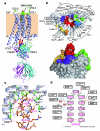G-protein-coupled receptor inactivation by an allosteric inverse-agonist antibody
- PMID: 22286059
- PMCID: PMC3303121
- DOI: 10.1038/nature10750
G-protein-coupled receptor inactivation by an allosteric inverse-agonist antibody
Abstract
G-protein-coupled receptors are the largest class of cell-surface receptors, and these membrane proteins exist in equilibrium between inactive and active states. Conformational changes induced by extracellular ligands binding to G-protein-coupled receptors result in a cellular response through the activation of G proteins. The A(2A) adenosine receptor (A(2A)AR) is responsible for regulating blood flow to the cardiac muscle and is important in the regulation of glutamate and dopamine release in the brain. Here we report the raising of a mouse monoclonal antibody against human A(2A)AR that prevents agonist but not antagonist binding to the extracellular ligand-binding pocket, and describe the structure of A(2A)AR in complex with the antibody Fab fragment (Fab2838). This structure reveals that Fab2838 recognizes the intracellular surface of A(2A)AR and that its complementarity-determining region, CDR-H3, penetrates into the receptor. CDR-H3 is located in a similar position to the G-protein carboxy-terminal fragment in the active opsin structure and to CDR-3 of the nanobody in the active β(2)-adrenergic receptor structure, but locks A(2A)AR in an inactive conformation. These results suggest a new strategy to modulate the activity of G-protein-coupled receptors.
Figures



References
-
- Warne T, Chirnside J, Schertler GFX. Expression and purification of truncated, non-glycosylated turkey beta-adrenergic receptors for crystallization. Biochim. Biophys. Acta. 2003;1610:133–140. - PubMed
-
- Collaborative Computational Project N. The CCP4 suite: programs for protein crystallography. Acta Crystallogr. D. 1994;50:760–763. - PubMed
-
- Emsley P, Cowtan K. Coot: model-building tools for molecular graphics. Acta Crystallogr. D. 2004;60:2126–2132. - PubMed
-
- Murshudov GN, Vagin AA, Dodson EJ. Refinement of macromolecular structures by the maximum-likelihood method. Acta Crystallogr. D. 1997;53:240–255. - PubMed
Publication types
MeSH terms
Substances
Associated data
- Actions
- Actions
Grants and funding
LinkOut - more resources
Full Text Sources
Other Literature Sources
Molecular Biology Databases
Research Materials

